

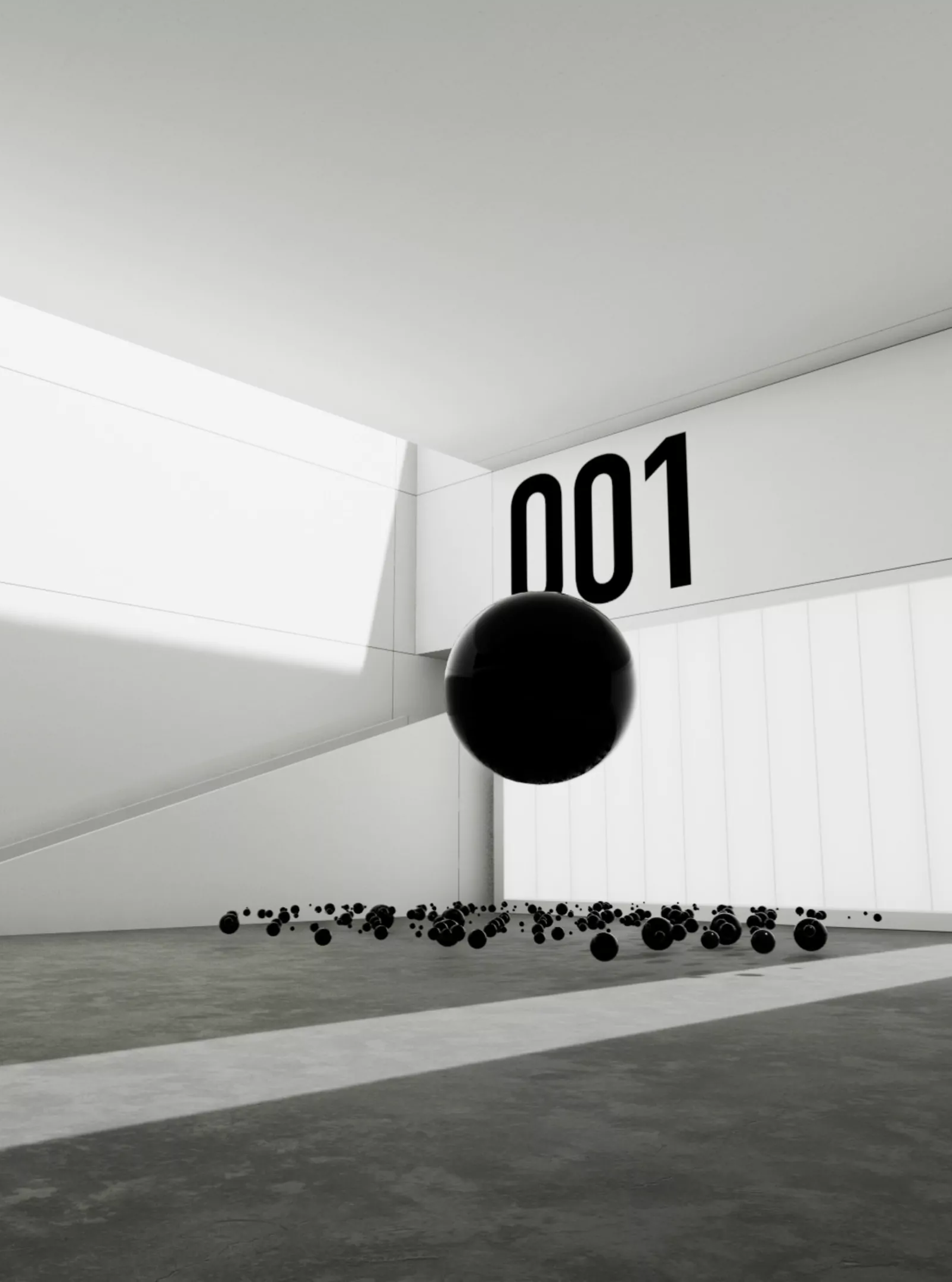
Maxim Zhestkov
Modules
Modules is a VR art experience, where architecture, sculpture, film, and music blend together to immerse viewers into Zhestkov’s world. A total work of art, it is a world that questions the established definitions of our reality. In digital space, we can abandon the logic of reality and are freed from its boundaries. New worlds with total freedom are possible, worlds only limited by our creativity and the potential of art.

QUBIT AI – International Electronic Language Festival – Art and Technology
QUBIT AI | quantum & synthetic ai
Electronic Language International Festival
July 3rd to August 25th
Tuesday to Sunday, 10am – 8pm
FIESP Cultural Center
Design: André Lenz
Image: Iskarioto Dystopian AI Films – Athena
QUBIT AI
In its 25 years of existence, the International Electronic Language Festival (FILE) is an internationally renowned Brazilian project that since 2000 has explored the intersection between art and technology. With more than two decades of history, the festival stands out for fostering exhibition spaces and debate about artistic innovations driven by disruptive and innovative technologies, inviting the public to get involved with experimental forms of art that challenge the boundaries of conventionality. Currently, two of these technologies stand out in the contemporary scenario: the accelerated development of quantum computing and artificial intelligence corroborated by synthetic data.
Quantum computing, an emerging revolution in the technological field, offers a new range of creative possibilities for contemporary artists. This new era allows the exploration of unprecedented frontiers through a new computational format that consists mainly of quantum superposition and entanglement, a new field of exploration for synthetic computer science, as well as for the arts in general; on the other hand, artificial intelligence, fueled by synthetic data, offers artists a new way of making and understanding art, opening up space for new forms, concepts and artistic expressions.
Entitled QUBIT AI, the exhibition delves into this unexplored territory presenting a selection of works of art resulting from the connection between artistic creation and technology, proposing a theoretical reflection on what the interrelationship between quantum computers and synthetic artificial intelligence will be.
Visitors will be invited to experience immersive installations, experimental videos, digital sculptures and other forms of interactive art, which intertwine reality and imagination. The exhibition encourages reflections on the influence of technology on art and contemporary society, while at the same time providing an environment to compare already established technological arts (analog and digital) with the possible futures of art in the synthetic era, enhanced by quantum computing. The QUBIT AI exhibition at FILE SP 2024 transcends the mere presentation of works of art; it is a journey to the limits of human creativity, driven by the convergence of art, science and technology.
Ricardo Barreto and Paula Perissinotto
co-organizers and curators of FILE
International Electronic Language Festival

QUBIT AI: AESTHETIC SYNTHETIC FILE – São Paulo 2024 – Art and Technology
FILE 2024
QUBIT AI | quantum & synthetic ai
Electronic Language International Festival
July 3rd to August 25th
Tuesday to Sunday, 10am – 8pm
FIESP Cultural Center
Design: André Lenz
Image: Iskarioto Dystopian AI Films – Athena
QUBIT AI
In its 25 years of existence, the International Electronic Language Festival (FILE) is an internationally renowned Brazilian project that since 2000 has explored the intersection between art and technology. With more than two decades of history, the festival stands out for fostering exhibition spaces and debate about artistic innovations driven by disruptive and innovative technologies, inviting the public to get involved with experimental forms of art that challenge the boundaries of conventionality. Currently, two of these technologies stand out in the contemporary scenario: the accelerated development of quantum computing and artificial intelligence corroborated by synthetic data.
Quantum computing, an emerging revolution in the technological field, offers a new range of creative possibilities for contemporary artists. This new era allows the exploration of unprecedented frontiers through a new computational format that consists mainly of quantum superposition and entanglement, a new field of exploration for synthetic computer science, as well as for the arts in general; on the other hand, artificial intelligence, fueled by synthetic data, offers artists a new way of making and understanding art, opening up space for new forms, concepts and artistic expressions.
Entitled QUBIT AI, the exhibition delves into this unexplored territory presenting a selection of works of art resulting from the connection between artistic creation and technology, proposing a theoretical reflection on what the interrelationship between quantum computers and synthetic artificial intelligence will be.
Visitors will be invited to experience immersive installations, experimental videos, digital sculptures and other forms of interactive art, which intertwine reality and imagination. The exhibition encourages reflections on the influence of technology on art and contemporary society, while at the same time providing an environment to compare already established technological arts (analog and digital) with the possible futures of art in the synthetic era, enhanced by quantum computing. The QUBIT AI exhibition at FILE SP 2024 transcends the mere presentation of works of art; it is a journey to the limits of human creativity, driven by the convergence of art, science and technology.
Ricardo Barreto and Paula Perissinotto
co-organizers and curators of FILE
International Electronic Language Festival

QUBIT AI: FILE QUANTUM WORKSHOP 2024 – São Paulo – Art and Technology
FILE 2024
QUBIT AI | quantum & synthetic ai
Electronic Language International Festival
July 3rd to August 25th
Tuesday to Sunday, 10am – 8pm
FIESP Cultural Center
Design: André Lenz
Image: Iskarioto Dystopian AI Films – Athena
QUBIT AI
In its 25 years of existence, the International Electronic Language Festival (FILE) is an internationally renowned Brazilian project that since 2000 has explored the intersection between art and technology. With more than two decades of history, the festival stands out for fostering exhibition spaces and debate about artistic innovations driven by disruptive and innovative technologies, inviting the public to get involved with experimental forms of art that challenge the boundaries of conventionality. Currently, two of these technologies stand out in the contemporary scenario: the accelerated development of quantum computing and artificial intelligence corroborated by synthetic data.
Quantum computing, an emerging revolution in the technological field, offers a new range of creative possibilities for contemporary artists. This new era allows the exploration of unprecedented frontiers through a new computational format that consists mainly of quantum superposition and entanglement, a new field of exploration for synthetic computer science, as well as for the arts in general; on the other hand, artificial intelligence, fueled by synthetic data, offers artists a new way of making and understanding art, opening up space for new forms, concepts and artistic expressions.
Entitled QUBIT AI, the exhibition delves into this unexplored territory presenting a selection of works of art resulting from the connection between artistic creation and technology, proposing a theoretical reflection on what the interrelationship between quantum computers and synthetic artificial intelligence will be.
Visitors will be invited to experience immersive installations, experimental videos, digital sculptures and other forms of interactive art, which intertwine reality and imagination. The exhibition encourages reflections on the influence of technology on art and contemporary society, while at the same time providing an environment to compare already established technological arts (analog and digital) with the possible futures of art in the synthetic era, enhanced by quantum computing. The QUBIT AI exhibition at FILE SP 2024 transcends the mere presentation of works of art; it is a journey to the limits of human creativity, driven by the convergence of art, science and technology.
Ricardo Barreto and Paula Perissinotto
co-organizers and curators of FILE
International Electronic Language Festival

QUBIT AI: FILE OPENING LECTURE 2024 – São Paulo – Art and Technology
FILE 2024
QUBIT AI | quantum & synthetic ai
Electronic Language International Festival
July 3rd to August 25th
Tuesday to Sunday, 10am – 8pm
FIESP Cultural Center
Design: André Lenz
Image: Iskarioto Dystopian AI Films – Athena
QUBIT AI
In its 25 years of existence, the International Electronic Language Festival (FILE) is an internationally renowned Brazilian project that since 2000 has explored the intersection between art and technology. With more than two decades of history, the festival stands out for fostering exhibition spaces and debate about artistic innovations driven by disruptive and innovative technologies, inviting the public to get involved with experimental forms of art that challenge the boundaries of conventionality. Currently, two of these technologies stand out in the contemporary scenario: the accelerated development of quantum computing and artificial intelligence corroborated by synthetic data.
Quantum computing, an emerging revolution in the technological field, offers a new range of creative possibilities for contemporary artists. This new era allows the exploration of unprecedented frontiers through a new computational format that consists mainly of quantum superposition and entanglement, a new field of exploration for synthetic computer science, as well as for the arts in general; on the other hand, artificial intelligence, fueled by synthetic data, offers artists a new way of making and understanding art, opening up space for new forms, concepts and artistic expressions.
Entitled QUBIT AI, the exhibition delves into this unexplored territory presenting a selection of works of art resulting from the connection between artistic creation and technology, proposing a theoretical reflection on what the interrelationship between quantum computers and synthetic artificial intelligence will be.
Visitors will be invited to experience immersive installations, experimental videos, digital sculptures and other forms of interactive art, which intertwine reality and imagination. The exhibition encourages reflections on the influence of technology on art and contemporary society, while at the same time providing an environment to compare already established technological arts (analog and digital) with the possible futures of art in the synthetic era, enhanced by quantum computing. The QUBIT AI exhibition at FILE SP 2024 transcends the mere presentation of works of art; it is a journey to the limits of human creativity, driven by the convergence of art, science and technology.
Ricardo Barreto and Paula Perissinotto
co-organizers and curators of FILE
International Electronic Language Festival

FILE 2024 – Call for Entries
The Call for Entries to participate in FILE – Electronic Language International Festival’s projects in 2024 is now open. The festival seeks original artworks in Art and Technology, by Brazilian and international artists. Registration remains open until February 10th. Access the registration form.
FILE is a non-profit cultural organization that has propagated creation and experimentation in Art and Technology through exhibitions, events and publications over 23 years. This call opens up the opportunity to participate in the 23rd. Edition of the Electronic Language International Festival, which is scheduled to take place at the FIESP Cultural Center, in São Paulo. The selected projects will also be able to collaborate in parallel events in different states in Brazil.
Using the registration form, it is possible to send interactive installations, sound art, video art, robotics, animations, CGI videos, virtual realities, augmented realities, mobile art, games, gifs, internet art, lectures and workshops, among others. To participate in the LED SHOW programm, exhibited annually at the FIESP Digital Art Gallery, register using the form. Sign up!

SETUP
COIL
The COIL installation is a space for reflection and a feeling of connection between people. COIL resembles a teleport and with this meaning it carries the phenomenon of teleportation. It is something impossible, but the consequences of escaping into it are instantaneous movement and farewell to eternal time. Any venue with art or raves is already an attempt to escape. So COIL pulls the viewer out of chronos and opens access to the eternal.

yoshio kubo
“DIFFERENT DIMENSION”
“Various winds are accumulated, pulled out, fluttered, rotated … Repeated over and over again. The invisible wind has the same expression for one second. Isn’t it possible to “see” with a dress that can’t be seen? It is a challenge to design your own style through dress making. ” yoshio kubo

Mima
MIMA
Aniara
“Early in the beginning of the film, we are introduced to a woman (Emelie Jonsson) who works on a kind of “attraction” of the spaceship called MIMA, which, at first, is not very popular. It is a technology capable of capturing people’s emotions. and turn them into images, or rather into a kind of vivid dream in their minds. As the ship wanders aimlessly through space, while it is not yet known if it is possible to return to the correct route, days become weeks, weeks become it takes months and the demand for MIMA increases. Aniara explores very well what makes us human as a race and also the importance of having a place to call her own. What was supposed to be a simple transport, over time becomes, in fact, a kind of “mini-planet”.” Marcio Melo
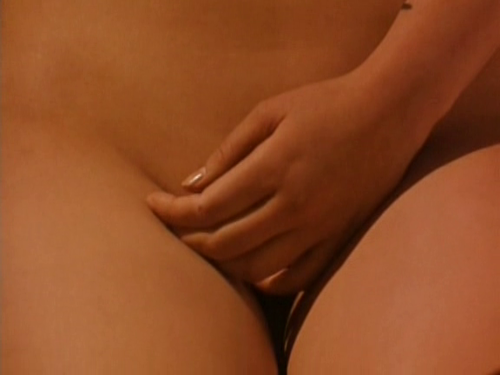
PETER GREENAWAY
بيتر غريناواي
彼得·格林纳威
פיטר גרינווי
ピーター·グリーナウェイ
피터 그리너웨이
Питер Гринуэй
The Pillow Book
Beautiful to behold and impossible to forget, THE PILLOW BOOK is auteur Peter Greenaway’s erotically-charged drama about love, death, revenge and the indelible nature of our earliest memories. Each year on her birthday, Nagiko (Vivian Wu) would became her father’s canvas, as he painted the creation myth in elaborate, elegant calligraphy on her body. Years later, she continues the practice with a succession of lovers, including a bisexual translator (Ewan McGregor) who becomes a pawn in an escalating game of vengeance against her beloved father’s exploitative publisher. Told in a series of chapters and featuring innovative cinematography and picture-in-picture techniques, Roger Ebert called THE PILLOW BOOK “a seductive and elegant story [that] stands outside the ordinary.”
cinema full

Balazs Kicsiny
Winterreise
Captured moments are central in Kicsiny’s installations. His characters are simultaneously frozen still and in motion. In some works this paradox becomes literal, as in the installation Winterreise that depicts two priests skiing in different directions using the same skis, which makes forward motion impossible. The figures seem lost, isolated and their journey endless. In their hands they hold Jacob’s staffs, navigational instruments used in the 17th century. The work alludes to the continuous search for one’s place in life.

Alexandr Grigorev
Scraps n19
This virtual sculpture impossible to create in physical world but still looks really real. It’s an example of post-reality that widely used in my practice.
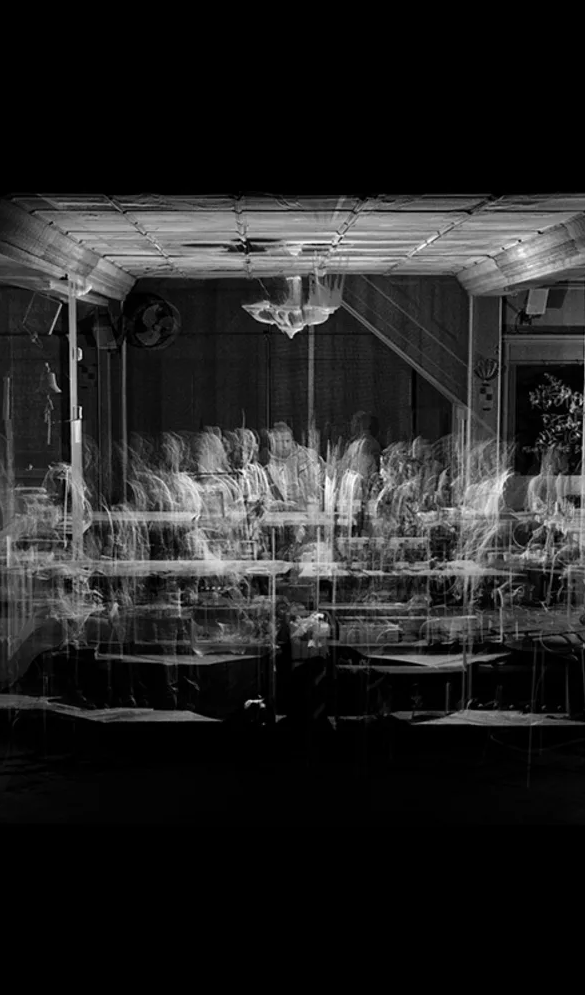
SCANLAB
FRAMERATE
Created from thousands of daily 3D time-lapse scans of British landscapes, the work observes change on a scale impossible to see with the lens of traditional cameras. This is not just an artwork. The data collected and presented by FRAMERATE is ground-breaking scientific research, containing empirical, measurable facts. We glimpse a future perpetually documented by the eyes of a billion autonomous vehicles and personal devices, creating high fidelity spatial records of the earth.
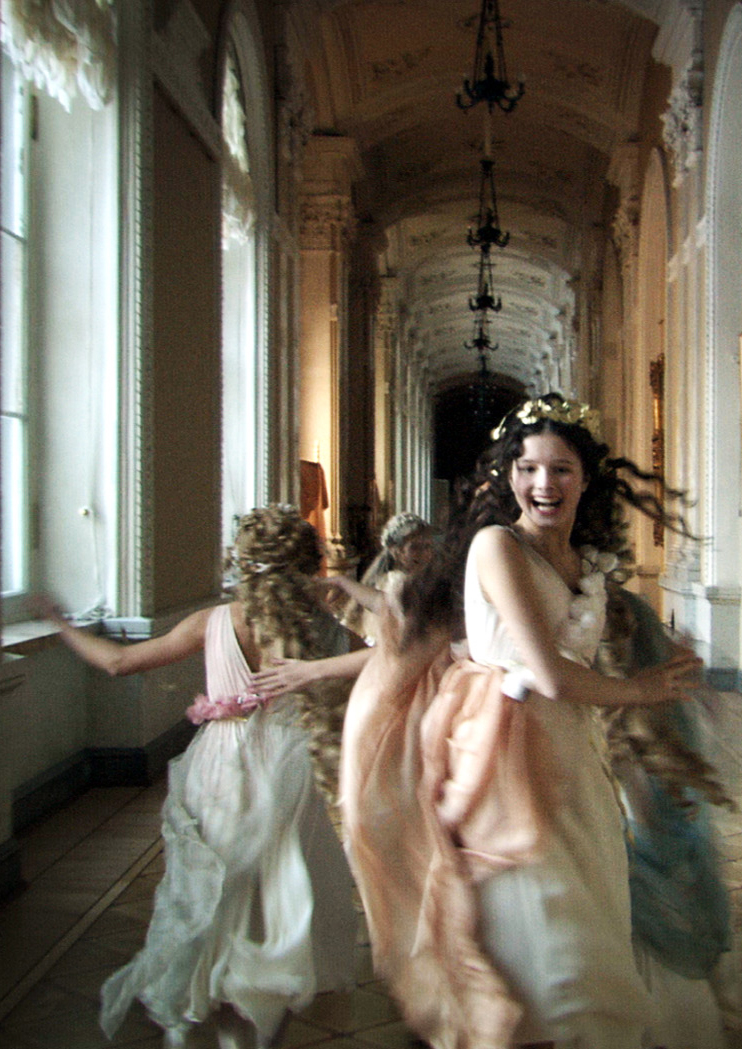
Aleksandr Sokurov
ألكسندر سوكوروف
亚历山大·索科洛夫
Александр Сокуров
Russian Ark
“Alexander Sokurov’s desire to film The Russian Arch in one continuous take required extraordinary technical solutions. Since it is physically impossible to shoot more than twelve minutes of conventional film, we had to shoot on video. However, it was only the relatively recent arrival of 24p high definition compact cameras that offered the visual quality and the ability to make this film for theaters, including transferring the digital image to a 35mm negative.With the help of German specialists a complex portable platform was designed to meet the demands of the scenario which included precise architectural plans, highlighting the distance of 1300 meters covered by the course of the action. It was decided that the only way to move the camera would be to use a steadycam, although we could not be sure until after the final image that such a long steadycam shot would be possible, given the physical performance. extreme demanded from the German cinematographer, Tilman Büttner. After months of rehearsals, the 867 actors and extras, the three “live” orchestras all had to know their position and precise roles “. It’s just amazing.
cinema full

Stelarc
StickMan
StickMan is a minimal but full-body exoskeleton that algorithmically actuates the artist with 6 degrees-of-freedom. It is a gesture generating system capable of 64 possible combinations. Sensors on StickMan generate sounds that augment the pneumatic noise and register the limb movements. A ring of 6 speakers directs and circulates the sounds.

Cassils
Inextinguishable fire
The title of the piece references Harun Farocki’s 1969 film of the same name, which approaches the impossible task of effectively depicting the horror of napalm on film. Cassils’s gesture of self-immolation speaks to both the desire for–and the impossibility of–knowing such horror, even while decisively aiming to approach it. Though the stunt is a simulation of violence, it still presents real danger. This possibly volatile situation–and the attempt to control it–is captured to create an image where danger, empathy for those experiencing violence, and the privilege of removal from such circumstance operate simultaneously in one transparent performance.

gordon matta clark
Anarchitecture
splitting house
“Of the many shows at the fabled 112 Greene Street gallery—an artistic epicenter of New York’s downtown scene in the 1970s—the Anarchitecture group show of March 1974 has been the subject of the most enduring discussion, despite a complete lack of documentation about it. Anarchitecture has become a foundational myth, but one that remains to be properly understood. Stemming from a series of meetings organized by Gordon Matta-Clark and reflecting his long-standing interest in architecture, the Anarchitecture exhibition was conceived as an anonymous group statement in photographs about the intersection of art and building. But did it actually happen? It exists only through oblique archival traces and the memories of the participants. Cutting Matta-Clark investigates the Anarchitecture group as a kind of collective research seminar, through extensive interviews with the protagonists and a dossier of all the available evidence. The dossier includes a collection of Matta-Clark’s aphoristic “art cards,” the 96 photographs that were produced by the various participants for possible inclusion in the exhibition, and images from a recently unearthed video of Matta-Clark’s now famous bus trip to see Splitting in Englewood, New Jersey.” Mark Wigley

The End of Time
TIMELAPSE OF THE FUTURE: A Journey to the End of Time
We start in 2019 and travel exponentially through time, witnessing the future of Earth, the death of the sun, the end of all stars, proton decay, zombie galaxies, possible future civilizations, exploding black holes, the effects of dark energy, alternate universes, the final fate of the cosmos.

Es Devlin
Blueskywhite
Devlin’s latest installtion is ‘BLUESKYWHITE’, a large-scale work commissioned by 180 Studios, which is currently showing at LUX: New Wave of Contemporary Art, a new exhibition co-curated by Fact and SUUM Project. The work combines light, music and language, and was conceived as a sculptural expression of our emotional response to the possible extinction of blue sky. The installation is formed of two parts: In Part I, text from Byron’s 1816 poem Darkness underscores the viewer’s passage through a 24m long red-lit tunnel. Part II draws from contemporary solar geo-engineering models documented by Elizabeth Kolbert and others which suggest that a haze of suspended particles might reduce global temperature to pre-industrial levels and might also turn the blue sky white.

Nicolas Bernier
frequencies (light quanta)
The project is part of an ongoing process entitled «frequencies», exploring basic sound and light dichotomic systems. Here, frequencies (light quanta) stems from a fascination towards science, light, and granular synthesis allowing to create clouds/grains of sounds. The conceptual focus lies in the quantum — the smallest measurable value of energy —, on the smallness of matter. The whole project is based on the possible conceptual relationships between basic quantum physics principles applied to the audio-visual creative process: particles, probabilities, wave/particle duality and discontinuity. Metaphorically structured around these notions, the audio-visual composition stems from 100 sound and light micro-sequences that develop themselves, generating an ever expending but yet disruptive form in time and space. With the use of randomness, the vectorial graphics are always creating new ways to look at the visual, physically superimposing pattern images.

OLEG SOROKO
Substance Numérique
La technologie paramétrique permet de générer un système auto-organisateur, c’est-à-dire d’ouvrir l’essence de l’univers comme une infinie variété de systèmes auto-organisateurs possibles. Le monde est en perpétuel processus d’auto-développement, mais ce n’est pas un chaos ni un ensemble de formes connues (cube, sphère, cylindre, à partir desquelles on peut tout construire comme le croyait Cézanne). Tout dans le monde (dans la réalité physique, biologique et autre) est dans des mouvements fluides, flexibles, fluides, accélérants et décélérants qui créent des tensions, des déchirures, des champs de force. Et ils sont incroyablement beaux (les attracteurs et les fractales sont leurs symptômes individuels) et ils existent avant la forme et après la forme. Ce n’est pas un solide ou des lignes dans un espace, mais quelque chose qui se tient avant et après l’espace.

Gary Hill
Cutting Corners Creates More Sides
A spoken text …rummages through piles of surplus; boxed accouterments and that unaccounted for miscellanea… and the uneasiness of language itself as it grapples with the whereabouts of the necessary words. The narrative debris morphs through manifolds of optical glass with each utterance marking points along the way. On a long, black tableaux two cameras with little or no depth of field, sentence by sentence cut through a mysterious world of a seemingly inconsequential lineup of objects, tools, parts, bits and the unidentifiable forgotten –whatever might have been close at hand becomes enfolded in a richly colored crystalline doppelgänger image. For each sentence and “drilling” through the objects, the cameras’ parallaxes have been adjusted for a different cross section—the point where momentarily a continuous horizontal view is possible only to then quickly deconstruct as quickly as it formed. The object/installation itself is a self-contained self-reflexive mobile surface complete with positional projectors and screens and a narrow black “runway” of sorts reflecting the initial process of recording.

Arcangelo Sassolino
The way we were
Not only does Arcangelo Sassolino transform failure into art, but he manages to make the art of failing a profound part of the art of living. He goes even further in the awareness of risk. He is aware that his experiments may not hold up to the forces that he himself puts in place but this possible collateral damage wants to represent an additional value, becoming precisely the existential metaphor of the concepts of risk and failure. His installations explore the behavior and mechanical limits of matter, he forces their characteristics to distort their shape, gravity, pressure, friction, statics, and of each possibility Sassolino contemplates the risks of collapse with its precise timing and programming.

ROBERT HENKE
光
光正在使用高精度激光在屏幕上绘制连续的抽象形状,并与声音完美同步。强烈的光线与完全的黑暗形成对比,缓慢的动作和微小细节的演化与强而有力的手势一样重要。结果既是古朴的又是未来主义的。新兴的模式为许多可能的解释留出了空间。象形文字,一种未知语言的符号,建筑图纸,数据点之间的连接或类似Tron的早期视频游戏放大了1000倍。
.
Light
Light is using high-precision lasers to draw continuous abstract shapes on the screen, perfectly synchronized with the sound. Intense light contrasts with total darkness, and slow movements and the evolution of small details are as important as strong gestures. The result is both quaint and futuristic. Emerging models leave room for many possible explanations. Hieroglyphs, symbols in an unknown language, architectural drawings, connections between data points, or early video games like Tron are magnified 1,000 times.
.
Lumière
La lumière utilise des lasers de haute précision pour dessiner des formes abstraites continues sur l’écran, parfaitement synchronisées avec le son. La lumière forte contraste avec l’obscurité totale, le ralenti et l’évolution des petits détails sont aussi importants que les gestes forts. Le résultat est à la fois pittoresque et futuriste. Les modèles émergents laissent place à de nombreuses explications possibles. Les hiéroglyphes, les symboles dans une langue inconnue, les dessins d’architecture, les connexions entre les points de données ou les premiers jeux vidéo comme Tron sont agrandis 1 000 fois.
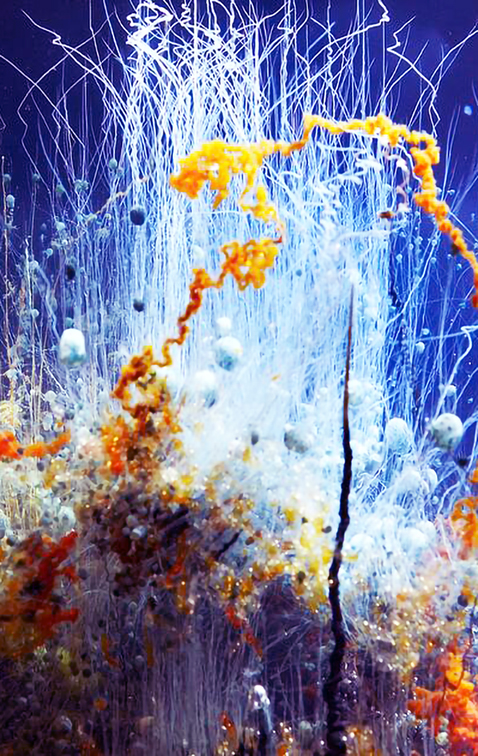
Hicham Berrada
Présage
Nurtured by a dual artistic and scientific background, Hicham Berrada’s work combines intuition and knowledge, science and poetry. In his works, he explores scientific protocols that mimic different natural processes and/or climatic conditions as closely as possible. “I try to control the phenomena I mobilize as a painter controls his pigments and brushes. My brushes and pigments would be temperature, magnetism, light.”

ZACH LIEBERMAN, JAMES POWDERLY, EVAN ROTH, CHRIS SUGRUE, TEMPT1, THEO WATSON
eye writer
TEMPT1, граффити-художник и активист из Лос-Анджелеса, в 2003 году был диагностирован боковым амиотрофическим склерозом (БАС), и вскоре после этого он был полностью парализован, за исключением глаз. Команда, разработавшая EyeWriter, оснастила пару очков технологией отслеживания взгляда и специальным программным обеспечением, которое могло улавливать движения глаз TEMPT1. Из своей больничной палаты, подключенной по беспроводной сети к ноутбуку и устройству для лазерной маркировки, установленному в центре Лос-Анджелеса, художник мог нарисовать свою метку и проецировать ее на здания в сверхчеловеческом масштабе в реальном времени, чтобы зрители могли видеть светящиеся граффити такими, какими они были созданный. Исследовательский проект EyeWriter был результатом сотрудничества TEMPT1, членов лаборатории Free Art & Technology (FAT), сообщества openFrameworks и лаборатории исследований граффити (GRL) при поддержке производственной компании Ebeling Group, фонда Not Impossible Foundation и Программа «Дизайн и технологии» в Новой школе дизайна «Парсонс», Нью-Йорк.

Pierre Malphettes
la fumee blanche
Le travail de Pierre Malphettes est à l’image d’une de ses œuvres, il agit sur nous comme un attracteur étrange. En travaillant principalement des matières intangibles telles que l’air, la lumière, l’eau, ou bien encore des matériaux bruts, de construction (la bâche, le caillebotis), Pierre Malphettes matérialise des espaces mentaux qui évoquent le voyage, le parcours. La poésie naît d’un déplacement contrarié, impossible,

Ryoichi Kurokawa
s.asmbli[wall]
Get immersed by 360° projections on a gigantic cube at OCT Loft Creative Festival and surround yourself with the power of nature. Thanks to a well-chosen combination of front and rear projection screens, you can enjoy the immersive fabric projections from every possible angle. To enhance the immersive 360-feel, several mirrors were placed around the eye-catching sculpture, reflecting the high-quality video mapping beautifully.

ANTONI RAYZHEKOV AND KATHARINA KÖLLER
Somaphonie
Somaphonie est composé d’objets électroniques autogènes qui répondent aux stimuli et aux contrôleurs portables de biofeedback. Comme il est lié au pouls cardiaque, à la tension musculaire et au mouvement des interprètes, la composition visuelle audiovisuelle en temps réel est possible. L’artiste explore l’interdépendance entre les équipements numériques et les interprètes qui expriment le comportement et la relation cybernétique (cerveau artificiel) à travers ce projet.

RICCARDO BLUMER
Mur
Riccardo Blumer Atelier a travaillé avec une équipe d’étudiants pour créer cette machine exposée à la Biennale d’architecture de Venise, qui est programmée pour construire et réparer un mur à bulles de 11 mètres de long. L’installation robotique, appelée Wall, est conçue pour mettre en évidence les limites des limites physiques. Il est programmé pour remplir un seul objectif: maintenir une structure complète en forme de mur composée de onze segments en forme de bulles aussi longtemps que possible.
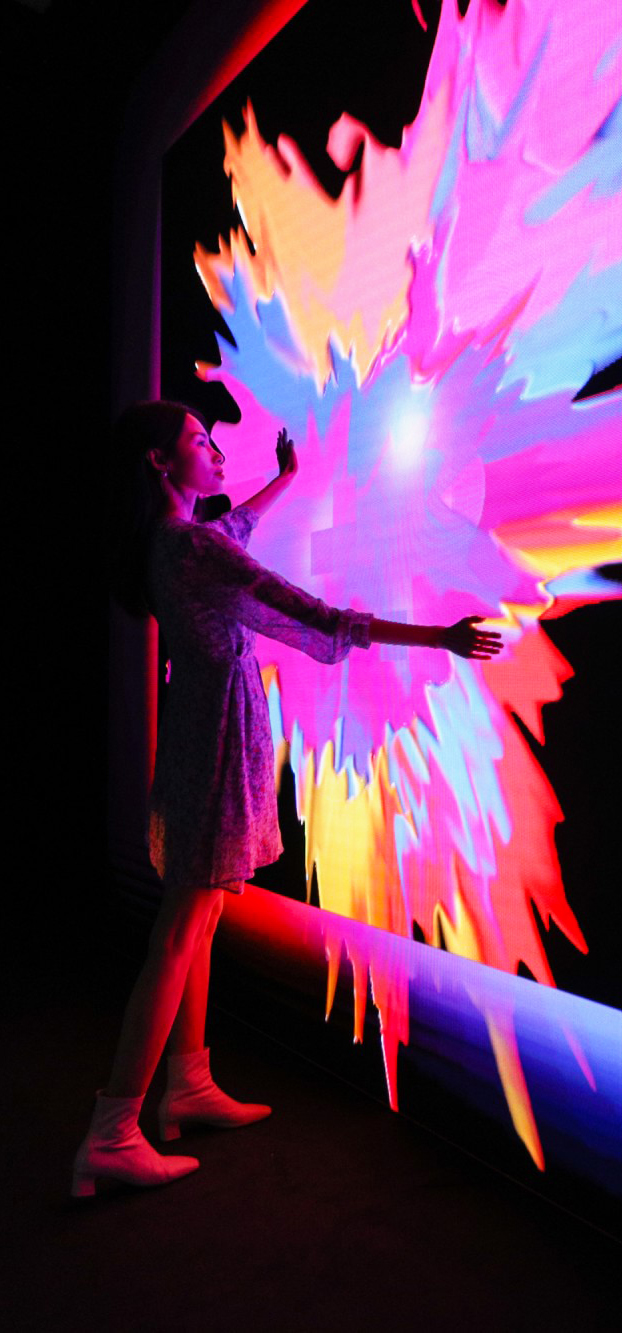
MOMENT FACTORY
Imagerie animiste
L’exposition présente aux visiteurs Duffy, l’artiste IA, avec une invitation à collaborer au sein de son studio Symbiotic. Cet espace immersif, rendu possible grâce à la projection mapping et à la technologie interactive, invite les invités à devenir l’égérie de l’IA. Alors que Duffy capture les mouvements générés par les visiteurs grâce à un suivi en temps réel, elle dessine des liens et des connexions, consultant une vaste collection de couleurs et d’images archétypales de la vie sur Terre. Le résultat est une série infinie d’œuvres d’art surprenantes – une interprétation artificielle de l’humanité et du monde naturel.

EMMANUEL VAN DER AUWERA
Vidéosculpture XXI
Les VideoSculptures de Van der Auwera prennent une nouvelle position pour explorer les intersections de la vie numérique et physique et comment le filtrage des images dans la production, la diffusion et la digestion modifie à la fois la perception individuelle et l’expérience consensuelle. Utilisant l’écran comme matériau sculptural, ces œuvres sortent les images du cadre de manière low-tech. Ils commencent par un acte de destruction alors que l’artiste prend littéralement un couteau sur un écran pour découper des couches physiques. À l’insu de la plupart, ces couches sont des filtres qui adhèrent à chaque écran LCD. Sans la médiation de ces filtres, les images deviennent impossibles à voir à l’œil nu et le bruit blanc remplit l’espace.
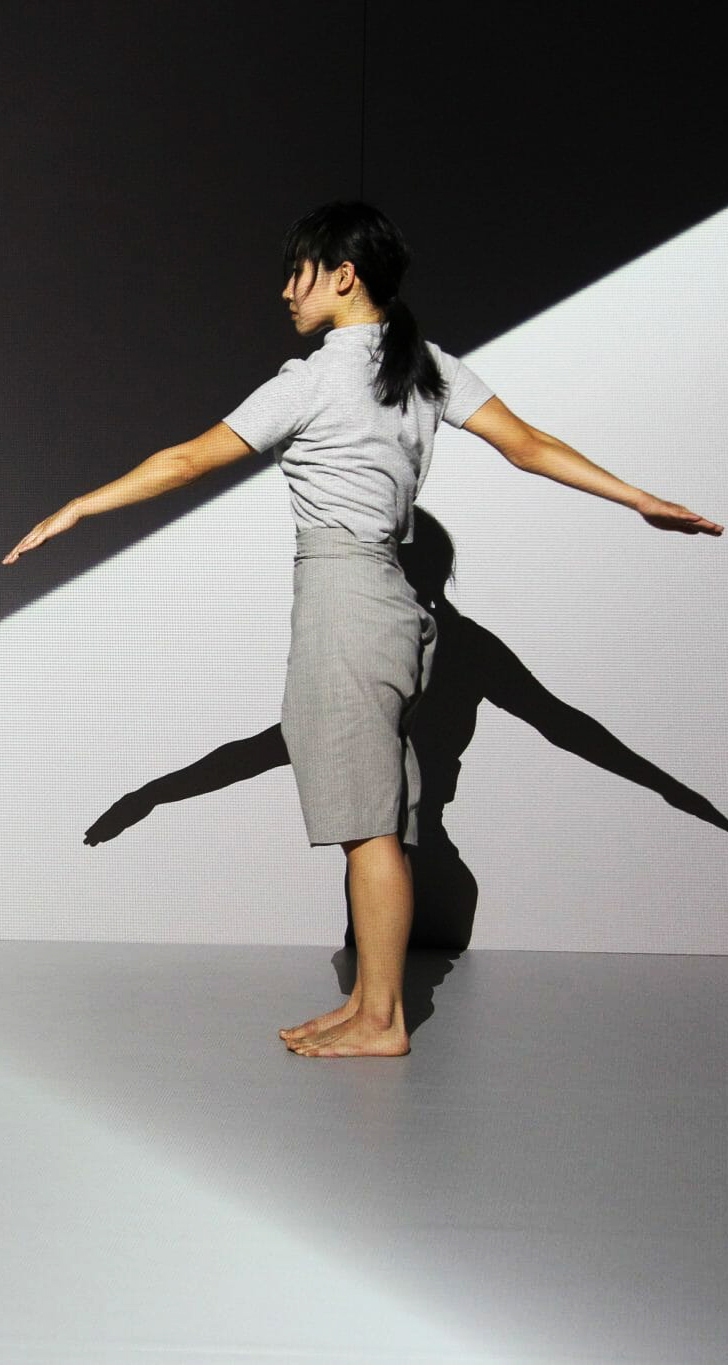
Urbanscreen
Spektrum
SPEKTRUM is an interplay of light, music and the performers. The use of projections in a theatrical context was a very pleasant experience for us, for when projections are used indoors, they can be controlled so precisely that amazing changes of perspective are possible. Once the stage is perceived as a platform, once as a white cube, once the spatial perception itself is completely challenged. As the three different elements of the performance merge into one unified language, SPEKTRUM is able to be many things at once: playful and yet fierce, touching and yet disturbing. Less a narrative than an emotional and sensory experience SPEKTRUM challenges the mind of the spectator in a quite a poetic way.

Kasuga
DMX Linear Actuator Slim
The motion study with the DMX Linear Actuator Slim demonstrates a synchronized kinetic sculpture with 25 components (vertical and horizontal mount) and a sphere fixture (black and white). Controlled by the DMX LA Designer software, multiple motion sequences, pattern generators and text and image contents are transferred onto the array. Furthermore, interaction with the kinetic sculpture is made possible via the Leap Motion Sensor, the Kinect Sensor and other mobile devices via the OSC protocol.

Eve Bailey
Rising Awareness
Could one succeed in rising the level of awareness by sharpening one’s perception rather than repeating the vapid catchphrase, “raising awareness,” which has been coopted by an ever-growing money-raising industry that fails to improve our circumstances in a substantive way? Wearing a cocktail dress, I assembled a large kinetic structure made of wooden beams and ladders in front of the audience. I then walked and balanced on the twenty-foot wide structure at eight feet off the floor. Rising Awareness addresses my ongoing preoccupations about the physicality of experience, inhabiting the body, proprioception as the possible strongest sense of self, how spatial awareness correlates with overall awareness and self-awareness, how physicality enhances creativity, finding balance between gravity and groundlessness, a concept of happiness as the fullest expression of one’s particular cognitive potential, pushing boundaries, and the current irreverent politics of liability.

Ricardo Barreto and Paula Perissinotto
CYBERDANCE
This net art by Ricardo Barreto and Paula Perissinotto offers us a split, fragmented, impossible dance, in a divided, multiplied space. Cyberdance consists of the combination and recombination of elements that represent the different parts of the human body. A mannequin was photographed as a model in different positions. These images were later converted to the animated form, allowing users to combine them in different ways, as well as link them to different dance terms, to the names of postures and positions of classical ballet. On a page divided into frames containing fragments of the mannequin, we can see his head, legs, torso and arms rotating, while allowing us to subdivide each frame by clicking on it, each frame composing an aberrant doll whose fragments dance, silently, independent one from the other. There is no music, no rhythm, no space. It is a digital dance, a dance in which time and space have become a platform.

VÍCTOR ENRICH
فيكتور إثراء
ビクターはエンリッチ
ВИКТОР ЭНРИХ
The artist definitely made a strong impression on the world of visual arts with his concepts. The ideas behind all his illustrations are very strong and full of substances, and manage to grasp the attention of the public from the first second. Aside from that, he also sends other, more subtle messages, regarding his own perspective upon the world, how he deems everything as possible for those who believe and who understand the power of imagination etc. The works of Victor Enrich really are something special, and worth taking a closer look. Without further ado, we invite you to admire the results of his restless imagination, his bold symbolism and his courageous approach to life and the world around us.
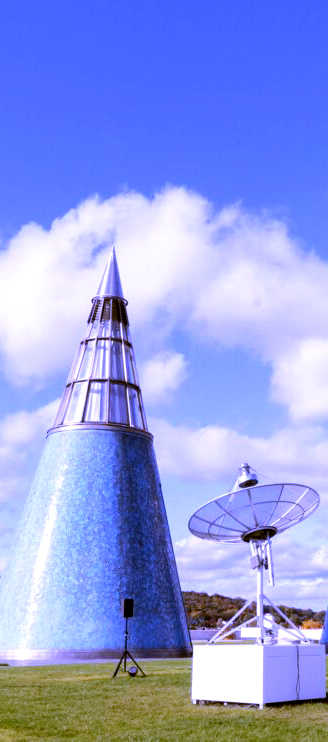
quadrature
Credo
A radio telescope scans the skys in search of signs of extraterrestrial life.
The received raw signals serve as input data for a neural network, which was trained on human theories and ideas of aliens. Now it tries desperately to apply this knowledge and to discover possible messages of other civilizations in the noise of the universe. Mysterious noises resound as the artificial intelligence penetrates deeper and deeper into the alien data, where it finally finds the ultimate proof.The sound installation revolves around one of the oldest questions of mankind – one that can never be disproved: Are we alone in the universe?

Antoni Rayzhekov and Katharina Köller
Somaphony
<somaphony> is composed of autogenous electronic objects that respond to stimuli and biofeedback wearable controllers. As it is connected with heart pulse, muscle tense, and movement of performers, real-time audiovisual visual composition is possible. The artist explores interdependence between digital equipment and performers that express behavior and cybernetic(artificial brain) relationship through this project.

Moment Factory
Animistic Imagery
The exhibit introduces visitors to Duffy, the AI Artist, with an invitation to collaborate inside her Symbiotic Studio. This immersive space, made possible through projection mapping and interactive technology, invites guests to become the AI’s muse. As Duffy captures movements generated by visitors through real-time tracking, she draws links and connections, consulting a vast collection of colors and archetypal images of life on Earth. The result is an infinite series of surprising works of art—an artificial interpretation of humanity and the natural world.

Jonathan Pepe
EXO-BIOTE
The Exo-biote project aims to invent a typology of possible forms and movements by diverting “soft robotics” technologies. The installation features moving sculpture-objects. These hybrid objects swell with air and seem to be alive, to breathe. These components are part of a whole, they belong to the same body, one whose humours and pulsing organs we can observe. A spasmodic choreography leads the viewer on an inner journey, into the meanders of one of those absurd reasoning processes that logicians calls “apagogies” by proposing hypothetical prostheses for the consumer market. It is as if the objects presented here were commodities, objects ready to use, mass-produced surrogate organs.
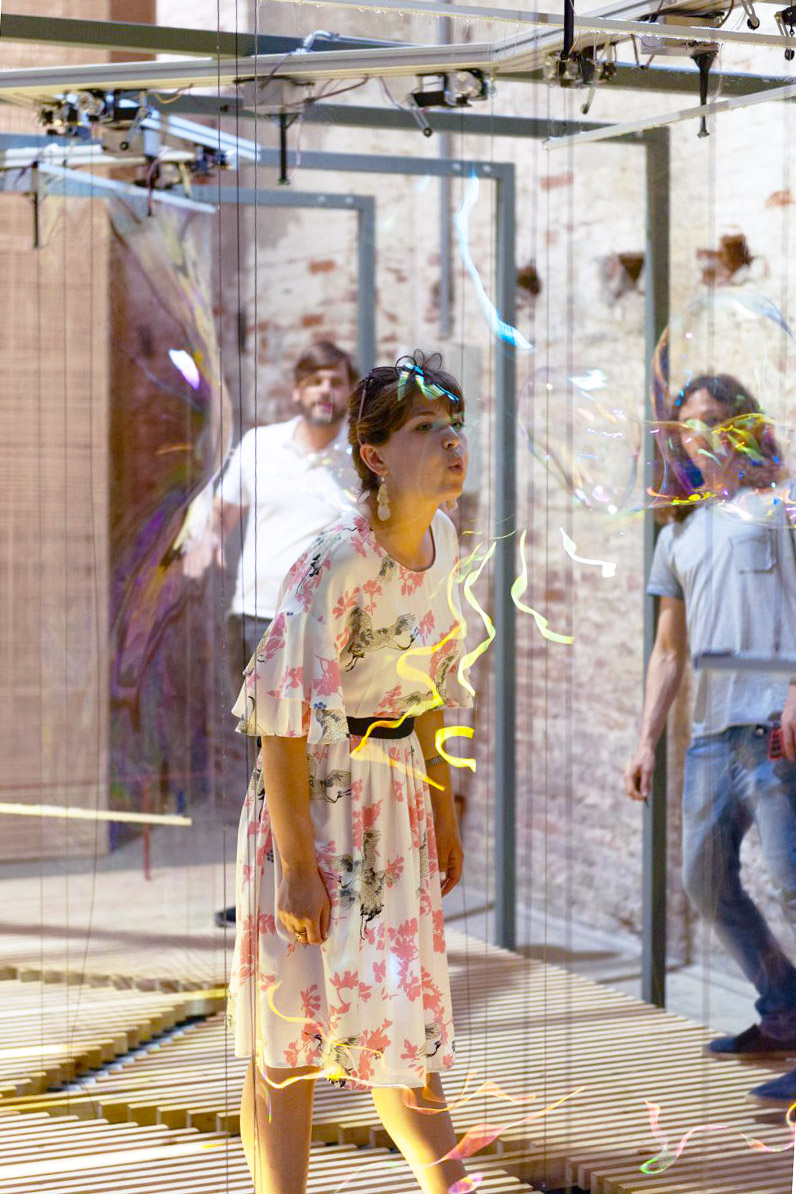
Riccardo Blumer
Wall
Riccardo Blumer Atelier worked with a team of students to create this machine on show at the Venice Architecture Biennale, which is programmed to build and repair an 11-metre-long bubble wall. The robotic installation, called Wall, is designed to highlight the limitations of physical boundaries. It is programmed to fulfil one goal: maintain a complete wall-like structure made up of eleven bubble-like segments for as long as possible.

ADRIEN M / CLAIRE B
The Movement of Air
A frontal show for three dancers evolving in an immersive environment made up of images projected, generated and animated live. A show where two impossible ones come together: the body that flies, thanks to suspension devices and the body that fits into the image. An acrobatic and digital choreographic writing which outlines a body language opening onto other relationships to time, space and the world. Beyond the search for technical prowess, it is that of a dreamlike movement and writing through images.

Ka Fai Choy
Synchrometrics
Can we design future memories for the body?
Is the body itself the apparatus for remembering cultural processes?Prospectus For a Future Body proposes new perspectives on how the body remembers and invents technological narratives. Central to the project is the study of body movement in dance: How it can evolve, adapt or re-condition to possible futures?Eternal Summer Storm explores the concept of muscle memory transfer as an alternative form of interactive cultural continuities. This concept prototype speculates on a future digital library of body movements or dance techniques that can be experienced beyond the audio-visual conventions. Eternal Summer Storm attempts to recreate legendary Japanese dancer Tatsumi Hijikata’s Butoh dance choreography and experience in ‘A Summer Storm’ (1973) from archival footages.Bionic Movement Research is a collection of experiments on the process of designing digital muscle memory for the body. Inspired by Luigi Galvani discovery (1780) of animal electricity in the human body, these experiments appropriate the techniques of electrical nerve stimulation to choreograph artificial muscle contraction and body movement.
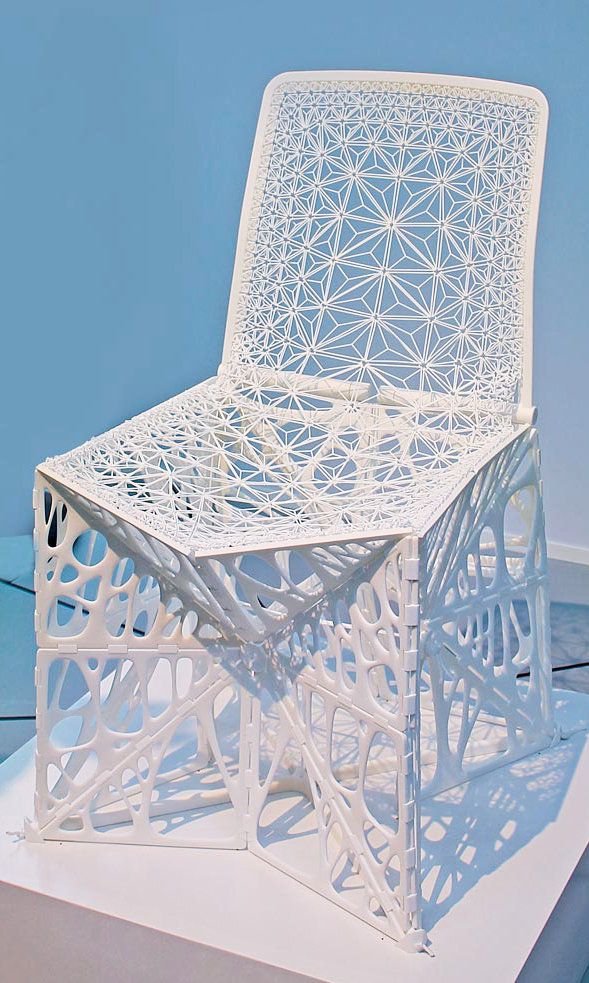
Patrick Jouin
The TAMU Chair
The result of the dialogue between designer and machine, Tamu is a foldable chair which takes up less space and the least amount of material possible to make.

SYD MEAD
In 1979, projects began to include work with most major studios, on such feature films as Star Trek: The Motion Picture, followed by, Bladerunner, TRON, 2010, Short Circuit, Aliens, Time Cop, Johnny Mnemonic, Mission Impossible-3, and most recently Elysium starring Jodi Foster and Matt Damon, Directed by Neill Blomkamp. Beginning in 1983, Syd began to develop close working relationships with a number of major Japanese corporate clients, including; Sony, Minolta, Dentsu, Dyflex, Tiger, Seibu, Mitsukoshi, Bandai, NHK and Honda as well as contributing to two Japanese film projects, The New Yamato and Crises 2050. In the 1990s’, Syd supplied designs for two Japanese toy icons, “The New Yamato” and all eight robot characters in the new Turn-A Gundam mobile suite series which were also seen as characters in Television shows.

GYÖRGY LIGETI
ג’רג’ ליגטי
Дьердь Лигети
ジェルジ·リゲティ
Le Grand Macabre
In the mid-70s, Ligeti wrote his only opera, Le Grand Macabre, loosely based on the 1934 play, La Balade du grand macabre, by Michel De Ghelderode. It is a work of absurd theatre that contains many eschatological references.After having seen Mauricio Kagel’s anti-operatic work Staatstheater, Ligeti came to the conclusion that it was not possible to write any more anti-operas.[citation needed] He therefore resolved to write an “anti-anti-opera”, an opera with an ironic recognition of both operatic traditions and anti-operatic criticism of the genre. From its brief overture, a mixture of rhythmic sounds scored for a dozen car horns, to the closing passacaglia in mock classical style, the work evolves as collage of sonorities ranging from a grouping of urban sounds to snippets of manipulated Beethoven, Rossini and Verdi.

Emmanuel Van Der Auwera
Videosculpture XXI
Van der Auwera’s VideoSculptures take a new position to explore the intersections of digital and physical life and how the filtering of images in production, dissemination, and digestion alter both individual perception and consensual experience. Using the screen as sculptural material, these works break images out of the frame in a low-tech manner. They start with an act of destruction as the artist literally takes a knife to a screen to carve away physical layers. Unbeknown to most, these layers are filters that are adhered to every LCD screen. Without the mediation of these filters, images become impossible to see with the naked eye and white noise fills the space.

MAURICE BOGAERT
Het Wezen van de Stad
For a couple of years now I’ve been developing a series of works that engage, each in different ways, with what I propose to call filmic architecture. In these works, I explore the relationships between scale models, sets, architecture, and the moving image. Starting point is was the question: would it be possible to do a remake of a film, let’s say Ridley Scott Alien, with a set that would allow one to do so in one single shot? How to translate the combination of spaces, montage and shifts in size and angle as we see them in the film into the actual spatiality of a set that would allow one to shoot the film in a single continuity without the cut and paste of montage? This brought me to the idea of the Morphed Set as both a potential plan for a work and an intellectual exercise or figure of thought. Sometimes my works are extremely large “walkthrough INSTALLATIONS” – at other times, they are infinite small scale models and prototypes.
.

